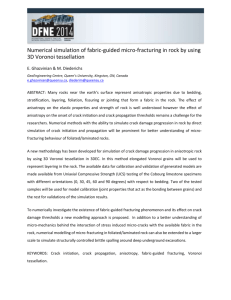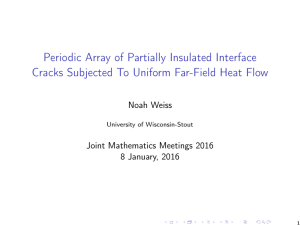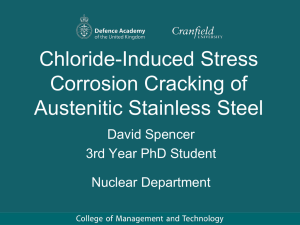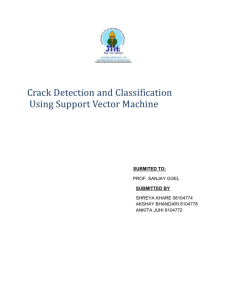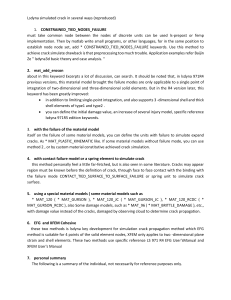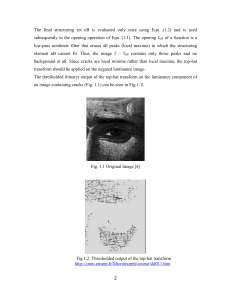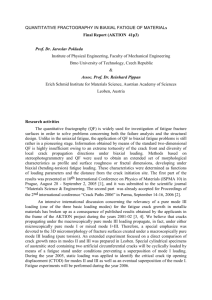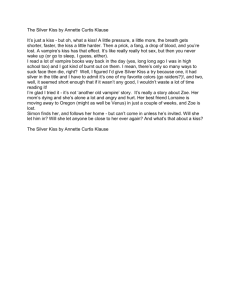WRITING AN EFFECTIVE ABSTRACT
advertisement
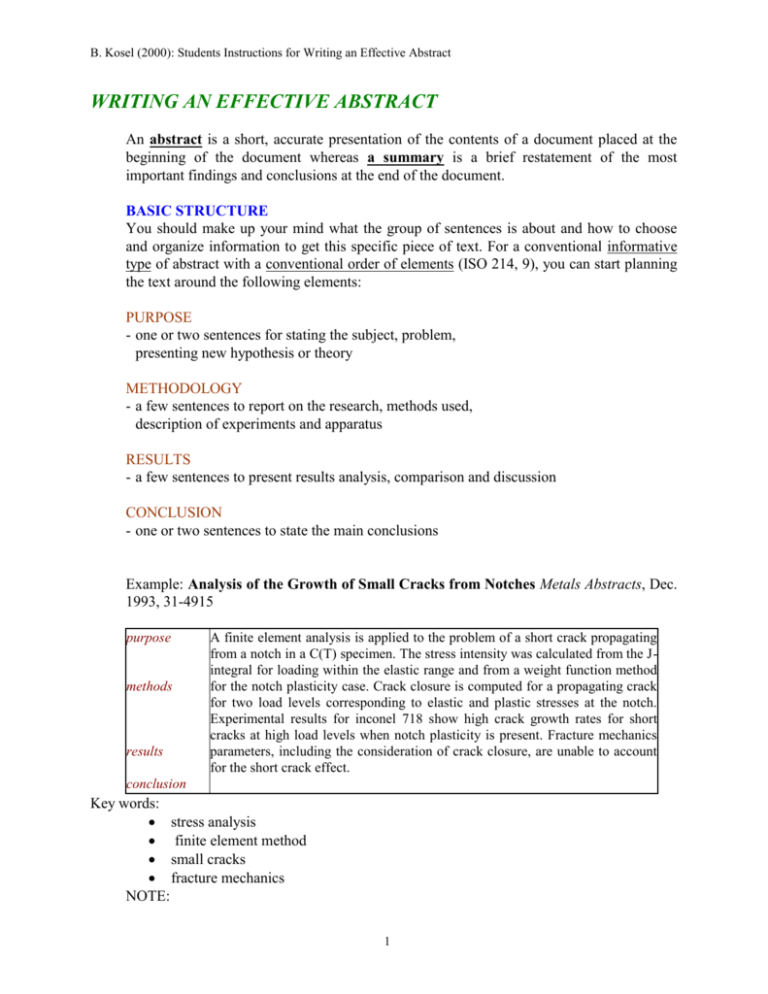
B. Kosel (2000): Students Instructions for Writing an Effective Abstract WRITING AN EFFECTIVE ABSTRACT An abstract is a short, accurate presentation of the contents of a document placed at the beginning of the document whereas a summary is a brief restatement of the most important findings and conclusions at the end of the document. BASIC STRUCTURE You should make up your mind what the group of sentences is about and how to choose and organize information to get this specific piece of text. For a conventional informative type of abstract with a conventional order of elements (ISO 214, 9), you can start planning the text around the following elements: PURPOSE - one or two sentences for stating the subject, problem, presenting new hypothesis or theory METHODOLOGY - a few sentences to report on the research, methods used, description of experiments and apparatus RESULTS - a few sentences to present results analysis, comparison and discussion CONCLUSION - one or two sentences to state the main conclusions Example: Analysis of the Growth of Small Cracks from Notches Metals Abstracts, Dec. 1993, 31-4915 purpose methods results A finite element analysis is applied to the problem of a short crack propagating from a notch in a C(T) specimen. The stress intensity was calculated from the Jintegral for loading within the elastic range and from a weight function method for the notch plasticity case. Crack closure is computed for a propagating crack for two load levels corresponding to elastic and plastic stresses at the notch. Experimental results for inconel 718 show high crack growth rates for short cracks at high load levels when notch plasticity is present. Fracture mechanics parameters, including the consideration of crack closure, are unable to account for the short crack effect. conclusion Key words: stress analysis finite element method small cracks fracture mechanics NOTE: 1 B. Kosel (2000): Students Instructions for Writing an Effective Abstract In an abstract you should also avoid using acronyms, abbreviations and symbols, or space permitting it, these should be defined the first time they occur in the abstract. Do not cite the references by the numbers from the list at the end of the document, or refer by number to an equation, table or similar used within the document. (cf. ISO 214, 4; Young 1989, 21; Barras 1991, 138). LANGUAGE FOCUS avoid the first person: I , we Not: In the diploma work I describe the possibilities of object recognition with a vision system. ... Better: In the diploma thesis possibilities of object recognition with a vision system are described. active verb preference Not: In the diploma work the effects of the workpiece technological past which is reflected in surface roughness as a quality feature in the fine turning process are studied. Better: The diploma thesis studies the effects of different technological past on the workpiece surface roughness as a quality feature in the fine turning process. Start your abstract with an inanimate subject and an active verb and then continue: The diploma thesis presents/studies/ deals with/ gives a survey of /focuses /develops.......... on/reports on The most frequent tense used is present simple. However, when reference is made to the author's own experiments, calculations, observations etc., the use of past tense is more appropriate to avoid ambiguity. By using past tense although there is no definite past time indicator, we point out the difference between general facts and the things the author did. Example: The fatigue crack growth behavior shows a transition from the plane strain state to plane stress state. The growth rate can be up to a decade lower in plane stress than in the plane strain state. Using a slant crack model and neglecting the crack growth due to shear, it was found that the transition from plane strain to plane stress correlated with the strain energy release rate, G. Test results from centre crack panel specimens of 7475-T731 Al alloy are presented. Metals Abstract Dec 1993, 31-4921 2 B. Kosel (2000): Students Instructions for Writing an Effective Abstract INFORMATIVE versus DESCRIPTIVE ABSTRACT Here below you will find two very brief abstracts of two papers presented at the same conference, which means 1) that both authors were faced with the same space limitations and that 2) both are reporting on experimental work from the same research field. The first is the descriptive type and the second informative. Read both of them and think which of them is more useful for the reader who is not in the position to read the whole document. Roughness-Induced Closure of Through-Thickness Short Fatigue Cracks A finite difference analysis of roughness-induced fatigue crack closure has been performed. The influence of crack surface geometry on opening and closure loads is discussed. The numerical results are compared with experimental measurements in the specimen. Metals Abstract, Dec 1993, 31-4785 Hydrogen Effects on Fatigue in a Duplex Stainless Steel Fatigue crack propagation rates have been determined for a duplex stainless steel, Zeron 100, in air, argon, hydrogen and water at a range of dissolved oxygen contents and temperatures. In gaseous H and water, the ferrite matrix suffers from H embrittlement in fatigue, failing by a brittle cyclic cleavage mechanism, whereas the austenite is unaffected. Metals Abstract, Dec 1993, 31-4813 Which of these abstracts leaves the reader guessing? Which abstract gives a better selection of information, more details? REFERENCES Barras, R. (1978 1991). Scientists must write, Reprint, London: Chapman and Hall Booth, V. (1993). Communicating in Science. 2nd ed., Cambridge: Cambridge University Press International Standardization Organization 214-1976 (E) Kosel B. (1998). “Writing Effective Abstracts for International Readers”. V R. de Beaugrande, M. Grosman, B. Seidelhofer (eds) Advances in Discourse Processes, Language Policy and Language Education in Emerging Nations: Focus on Slovenia and Croatia and with Contributions from Britain, Austria, Spain and Italy, Vol LXIII, p 237 - 245 Young, M. ( 1989). The Technical Writer's Handbook. Milly Valley, CA 94941: University Science Books Lobban, Ch.S. and M.Schefter (1992). Successful Lab Reports. Cambridge: Cambridge University Press Turk, Ch. and J. Kirkman (1989). Effective Writing, 2nd edn., London: E & FN Spon 3



